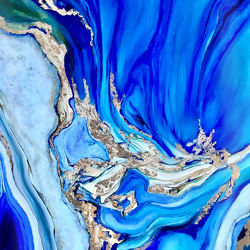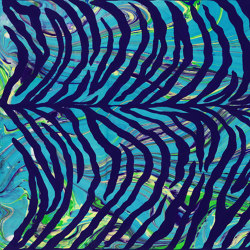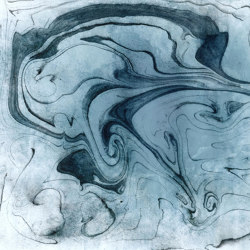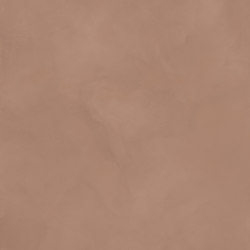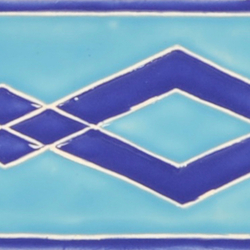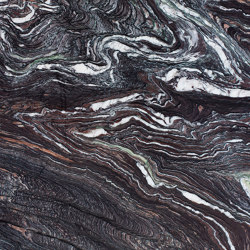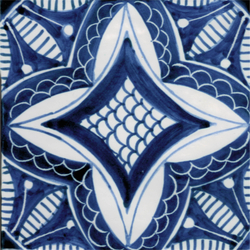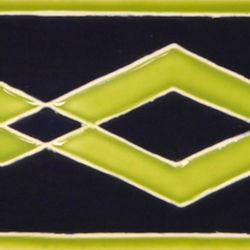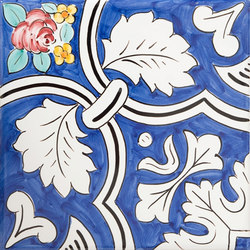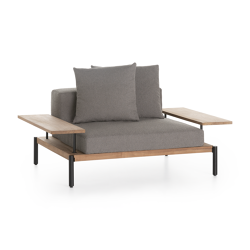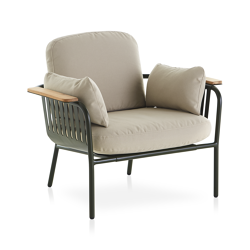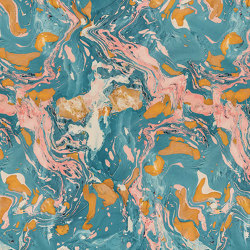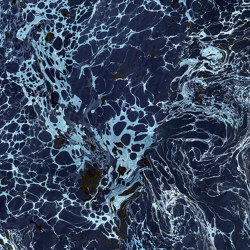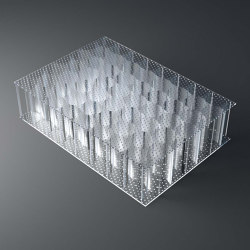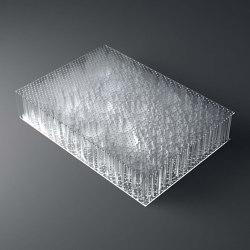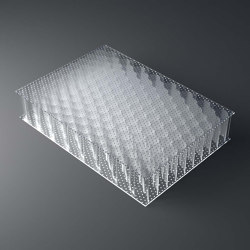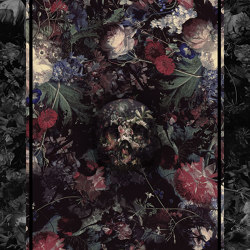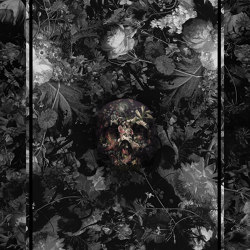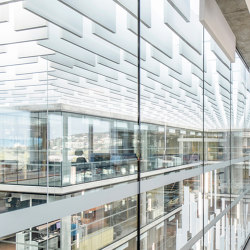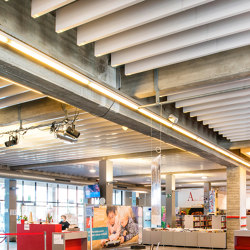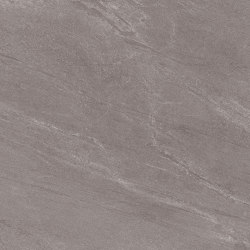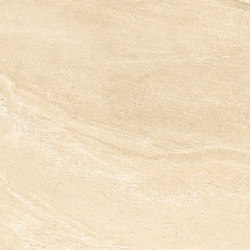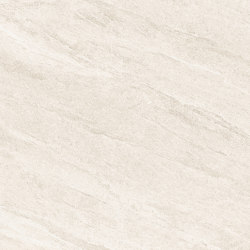Caribbean Dichrolam
Decorative glass from John Blazy Designs, Designed by John Blazy
Product description
Bright, opaque lamination exhibiting the South Beach colors of light teal and coral with copper/gold reflective highlights in smooth, graceful waves. Designed for opaque surfacing like Black Sea, Caribbean has been used at the Rio casino in Las Vegas behind all the light sconces on its restaurant walls for warm and exotic lighting effects.
Concept
Composition – Dichrolam decorative surfacing / window glazing / lighting diffractor sheet product is a semi structural laminated sheet product of glass or plastic, exhibiting transmissive and/or reflective color-changing characteristics. The “Sea” Series of Dichrolam (Black Sea, Crystal Sea, and Caribbean) have the added property of actual textural wave embossing. DichroMetallic Dichrolam is experimental at this stage, and most of the following limitations apply to DichroMetallic Dichrolam, although specifics require approval by JBD
Basic Uses – Available in glass plate form, and plastic in vertical, horizontal, flooring, flexible and limited thermoformable grades. It is recommended for interior, as well as exterior applications such as general and sloped glazing (vertical glass as well as skylight glass), partition walls, decorative tiles and opaque surfacing, signage, point of purchase displays, bar tops, desks, conference tables, occasional furniture, displays or whenever a visually dynamic, full spectrum color shifting appearance with actual three dimensional depth texturing is a desirable part of the design concept, whether backlighting or using for opaque surfacing.
LIMITATIONS
Some Dichrolam (plastic based, and/or Dichrolam NOT made into IG units) should be specified for interior application only where temperature and humidity levels are normal. Use outside of this stipulation is the risk of buyer, based on situational specifics too broad for coverage in this warranty.
All dichroic laminates installed in areas that are subject to constant moisture should be edge sealed in a frame with a waterproof sealants such as silicone or butyl type sealants. Any moisture related damage over time is the risk of buyer. Moisture damage to Dichrolam is always a result of improper sealing by installing contractor or sealant failure, therefore great care must be undertaken to correctly seal Dichrolam panels in framed applications. Aggressive fabricating and cutting techniques by buyer increase risk of delamination at buyers risk.
Due to the unique, hand made lamination procedure, optical thin film dichroic core uniqueness, its high reflectivity and said reflectivity’s ability to disguise and hide minor imperfections, the following minor visual aberrations are allowable in the dichroic layer core of these dichroic laminates, not covered under warranty:
· Occasional bubbles / air pockets in optical core
· Microbubbles may be present throughout, though undetectable at two foot viewing distance.
· Occasional dust specs or foreign matter within lamination layer due to manual, “hand made” nature of the manufacture.
· Edge fissures of air pockets at edges that may or may not show up over one month to two years time. This occurs due to “drying” of lamination adhesive at edge, and shrinkage of substrate due to off- gassing. This is accelerated in exterior or moist conditions, but generally will not “creep” beyond 1” from edge. Low - solvent sealants applied to edge reduce this occurrence. High – solvent adhesives at edge accelerate this occurrence.
· Color uniformity. Transmitted and reflected colors are subject to the quality of the dichroic films used in creating these exotic laminates, and there will always be minor bands of color or intensity deviations that are impossible to prevent as the films very high – tech and are the only ones of their kind, and deviations like this are very difficult to detect.
All storage, handling, and final applications / mounting of any construction of JBD dichroic laminates must be protective of surfaces from scratching. The following limitations must not be exceeded:
· Storage: Indoor, vertical or flat storage is recommended
· Be sure to protect edges and surfaces during transport. Aggressive banding, strapping and tying down of sheets without corner protectors will damage sheets
· Cold forming or thermoforming of any radius bends under ten inches where dichroic film layer is on inside surface of radius in final installation. Film on outside surface is fine in any radius (1st face plastic only, not the “Sea” series).
· Overtightened fastening through sheets
· Exposure of all or part of sheet (mainly plastic laminations) to extreme temperature sources like direct sunlight, hot or cold vents, or friction induced heat from poor fabrication.
JBD dichroic laminates must be used sufficiently supported, and opaque backed products should be soft bonded AT EDGES ONLY to an appropriate substrate with similar expansion / contraction coefficient.
These “soft bond” adhesives allow for interfacial movement as buffer zone between sheet products of varying dimensional stability to reduce shear stresses that WOULD RESULT IN WAVINESS OR OTHER DEVIATIONS.
Polycarbonate, PETG, and acrylic laminations are recommended for non-wear applications only, because of its lower resistance to surface abrasion. Although some Dichrolam constructions are protected by a scuff-resistant coating, plastic based Dichrolam is not recommended for heavy use horizontal applications (e.g. flooring, kitchen counters, restaurant service counters, etc.).
FABRICATION
Plastic based Dichrolam: Fabrication techniques are fairly straightforward requiring tooling normally used in most plastic fabrication and cabinet shops. Cutting/edging tools recommended:
· Plastic scoring knives
· Table or Beam / panel circular saws: triple-chip grind and negative-hook alternate bevel grind carbide circular saw blades. Cut Dichrolam with dichroic film face up, so blades cut through film first, backed by the plastic substrate. Dull, or aggressive blades (fewer than 60 tooth) can create melt burrs or micro chips to go into lamination core and cause delamination bubbles over time at edges. Always use sharp blades.
· Band saws (create least aggressive cutting process)
· Spiral Carbide routers/milling heads: also low aggression cutting when film surface of Dichrolam is sheared in a down-shear cutting action through the film layer. Clean bits frequently to keep from gumming up bit.
· Wet sanding and buffing edges are best to create polished edge. Flame polishing is not recommended.
Adhesives:
Most solvent based and two part adhesives work well, with no adverse effects, as long as adhesive is not onto dichroic film surface (weak bond, causing delamination), therefore Dichroic film needs to be removed in areas requiring adhesive.
Annealed glass based Dichrolam : Fabrication techniques are fairly straightforward requiring tooling normally used in most glass fabrication shops. Cutting/edging tools recommended:
· Glass cutters (score and snap method): For annealed laminated glass versions of Dichrolam, cut like normal laminated glass by scoring one face with a good oiled cutter, run the split, then flip over and score and split opposite side. Do not use flame method to melt interlayer – simply flex and run a razor to split. Diamond saws and waterjet cutting is very good. First surface glass Dichrolam (dichroic film exposed on one face with masking) is most often cut like normal float glass with the exception of slitting through the film layer first, then scoring and snapping the opposite side with a good oil cutter.
· Edging: Cup wheel, peripheral wheel, flexible diamond discs, 3M Trizact polishing discs and Cerium polishing felt can be used in laminated glass Dichrolam. First surface Dichrolam can be polished only if care is taken on the film edge. Grinding/polishing operations must cut “down” across film against glass, otherwise delamination at edge will occur.
Adhesives:
Limited soldering procedures (for stained glass applications) are possible if method imparts least amount of heat to dichroic film face through use of shields etc. UV Glues are best, as long as adhesive is not onto film surface (weak bond).
Dichrolam laminations:
Install in frames only or sealed mortices – not intended for applications with exposed edges or bonded field (bonding of field vs edge bonding is only possible when Dichrolam Sea textures are made into IG units, and bonding to the glass backing). Product designed primarily as table/bar tops where the clear glass or plastic face is exposed, not textured film back. This means that the textured side with the cloth/foam backer is NOT designed for bonding to substrate with ANY adhesive – must be dry mount where bonding is at edges only such as grout in tile application, groove of frame, or silicone flush set (tabletops). A common method is to make a razor cut through the textured film side about ¼” to 1” parallel to edge and then razor scrape this margin of film layer off to reveal the bare glass (plastic is possible too, but requires care in removal of film to protect plastic). This margin can now be filled with sealant and bonded to substrate (see “Typical Applications” page). If large glass/plastic tiles are utilized in wall or table top application (Crystal Sea, Black Sea, Caribbean, etx.), support should be from edges only, and adhesive/sealant used should be silicone or polyurethane, not solvent-based adhesive. Typical edging is a polished arris (eased-over top corner) on top edge. Full polished flat edging techniques are made at JBD factory.
On plastic-based Dichrolam, inside radius bends may delaminate if dichroic film face is to inside. All cold-forming is risk of buyer. All applications should be approved by this office, as Dichrolam is a unique material with unique limitations.
MAINTENANCE
Surfaces should be cleaned using a clean, soft cotton cloth with normal glass cleaners. Isopropyl alcohol is strongest solvent recommended for plastic based Dichrolam – no MEK, acetone or similar solvents. Abrasive cleaners, strong ammonia or alkaline solutions should always be avoided unless glass based products are used.
Light surface scratches on dichroic film layer may be repaired with the aid of various buffing compounds like swirl mark removers / machine glaze, but care must be taken not to buff through protective surface of the top layer of film.
SIZE AVAILABILITY, COLOR AND COST
Available in generally unlimited lengths up to 12 to 15 feet, custom cut to size and shapes, but limited to the following widths:
· 52” for most laminations.
· Colors for Crystal Sea are “Red” and “Green”. Color spec is based on reflection color at perpendicular viewing against a dark background, and transmitted color is always complimentary (opposite) to reflected color – all the way through the color shift.
· Transmission color for “Red” at right angle viewing will be aqua blue/green, shifting through deep blue, then magenta at skew angle viewing, while reflection color will be copper / red shifting through yellow / gold and into green at skew angles.
· Transmission color for “Green” at right angle viewing will be magenta / purple, shifting through orange, then yellow at skew angle viewing, while reflection color will be green shifting into deep blue at skew angles.
· Colors for Black Sea need no color spec as the dichroic films used are always “Blue” unless specifying special runs of “Green” or “Red” (Blue is best).
· Colors for Caribbean need no color spec as the dichroic films used are always “Red” but with the added step of backpainting white (it is essentially Crystal Sea made into opaque surfacing).
All costs are by custom quote only, although it is roughly 25% of the cost of common dichroic glass. Call authorized representative.
Basic Uses – Available in glass plate form, and plastic in vertical, horizontal, flooring, flexible and limited thermoformable grades. It is recommended for interior, as well as exterior applications such as general and sloped glazing (vertical glass as well as skylight glass), partition walls, decorative tiles and opaque surfacing, signage, point of purchase displays, bar tops, desks, conference tables, occasional furniture, displays or whenever a visually dynamic, full spectrum color shifting appearance with actual three dimensional depth texturing is a desirable part of the design concept, whether backlighting or using for opaque surfacing.
LIMITATIONS
Some Dichrolam (plastic based, and/or Dichrolam NOT made into IG units) should be specified for interior application only where temperature and humidity levels are normal. Use outside of this stipulation is the risk of buyer, based on situational specifics too broad for coverage in this warranty.
All dichroic laminates installed in areas that are subject to constant moisture should be edge sealed in a frame with a waterproof sealants such as silicone or butyl type sealants. Any moisture related damage over time is the risk of buyer. Moisture damage to Dichrolam is always a result of improper sealing by installing contractor or sealant failure, therefore great care must be undertaken to correctly seal Dichrolam panels in framed applications. Aggressive fabricating and cutting techniques by buyer increase risk of delamination at buyers risk.
Due to the unique, hand made lamination procedure, optical thin film dichroic core uniqueness, its high reflectivity and said reflectivity’s ability to disguise and hide minor imperfections, the following minor visual aberrations are allowable in the dichroic layer core of these dichroic laminates, not covered under warranty:
· Occasional bubbles / air pockets in optical core
· Microbubbles may be present throughout, though undetectable at two foot viewing distance.
· Occasional dust specs or foreign matter within lamination layer due to manual, “hand made” nature of the manufacture.
· Edge fissures of air pockets at edges that may or may not show up over one month to two years time. This occurs due to “drying” of lamination adhesive at edge, and shrinkage of substrate due to off- gassing. This is accelerated in exterior or moist conditions, but generally will not “creep” beyond 1” from edge. Low - solvent sealants applied to edge reduce this occurrence. High – solvent adhesives at edge accelerate this occurrence.
· Color uniformity. Transmitted and reflected colors are subject to the quality of the dichroic films used in creating these exotic laminates, and there will always be minor bands of color or intensity deviations that are impossible to prevent as the films very high – tech and are the only ones of their kind, and deviations like this are very difficult to detect.
All storage, handling, and final applications / mounting of any construction of JBD dichroic laminates must be protective of surfaces from scratching. The following limitations must not be exceeded:
· Storage: Indoor, vertical or flat storage is recommended
· Be sure to protect edges and surfaces during transport. Aggressive banding, strapping and tying down of sheets without corner protectors will damage sheets
· Cold forming or thermoforming of any radius bends under ten inches where dichroic film layer is on inside surface of radius in final installation. Film on outside surface is fine in any radius (1st face plastic only, not the “Sea” series).
· Overtightened fastening through sheets
· Exposure of all or part of sheet (mainly plastic laminations) to extreme temperature sources like direct sunlight, hot or cold vents, or friction induced heat from poor fabrication.
JBD dichroic laminates must be used sufficiently supported, and opaque backed products should be soft bonded AT EDGES ONLY to an appropriate substrate with similar expansion / contraction coefficient.
These “soft bond” adhesives allow for interfacial movement as buffer zone between sheet products of varying dimensional stability to reduce shear stresses that WOULD RESULT IN WAVINESS OR OTHER DEVIATIONS.
Polycarbonate, PETG, and acrylic laminations are recommended for non-wear applications only, because of its lower resistance to surface abrasion. Although some Dichrolam constructions are protected by a scuff-resistant coating, plastic based Dichrolam is not recommended for heavy use horizontal applications (e.g. flooring, kitchen counters, restaurant service counters, etc.).
FABRICATION
Plastic based Dichrolam: Fabrication techniques are fairly straightforward requiring tooling normally used in most plastic fabrication and cabinet shops. Cutting/edging tools recommended:
· Plastic scoring knives
· Table or Beam / panel circular saws: triple-chip grind and negative-hook alternate bevel grind carbide circular saw blades. Cut Dichrolam with dichroic film face up, so blades cut through film first, backed by the plastic substrate. Dull, or aggressive blades (fewer than 60 tooth) can create melt burrs or micro chips to go into lamination core and cause delamination bubbles over time at edges. Always use sharp blades.
· Band saws (create least aggressive cutting process)
· Spiral Carbide routers/milling heads: also low aggression cutting when film surface of Dichrolam is sheared in a down-shear cutting action through the film layer. Clean bits frequently to keep from gumming up bit.
· Wet sanding and buffing edges are best to create polished edge. Flame polishing is not recommended.
Adhesives:
Most solvent based and two part adhesives work well, with no adverse effects, as long as adhesive is not onto dichroic film surface (weak bond, causing delamination), therefore Dichroic film needs to be removed in areas requiring adhesive.
Annealed glass based Dichrolam : Fabrication techniques are fairly straightforward requiring tooling normally used in most glass fabrication shops. Cutting/edging tools recommended:
· Glass cutters (score and snap method): For annealed laminated glass versions of Dichrolam, cut like normal laminated glass by scoring one face with a good oiled cutter, run the split, then flip over and score and split opposite side. Do not use flame method to melt interlayer – simply flex and run a razor to split. Diamond saws and waterjet cutting is very good. First surface glass Dichrolam (dichroic film exposed on one face with masking) is most often cut like normal float glass with the exception of slitting through the film layer first, then scoring and snapping the opposite side with a good oil cutter.
· Edging: Cup wheel, peripheral wheel, flexible diamond discs, 3M Trizact polishing discs and Cerium polishing felt can be used in laminated glass Dichrolam. First surface Dichrolam can be polished only if care is taken on the film edge. Grinding/polishing operations must cut “down” across film against glass, otherwise delamination at edge will occur.
Adhesives:
Limited soldering procedures (for stained glass applications) are possible if method imparts least amount of heat to dichroic film face through use of shields etc. UV Glues are best, as long as adhesive is not onto film surface (weak bond).
Dichrolam laminations:
Install in frames only or sealed mortices – not intended for applications with exposed edges or bonded field (bonding of field vs edge bonding is only possible when Dichrolam Sea textures are made into IG units, and bonding to the glass backing). Product designed primarily as table/bar tops where the clear glass or plastic face is exposed, not textured film back. This means that the textured side with the cloth/foam backer is NOT designed for bonding to substrate with ANY adhesive – must be dry mount where bonding is at edges only such as grout in tile application, groove of frame, or silicone flush set (tabletops). A common method is to make a razor cut through the textured film side about ¼” to 1” parallel to edge and then razor scrape this margin of film layer off to reveal the bare glass (plastic is possible too, but requires care in removal of film to protect plastic). This margin can now be filled with sealant and bonded to substrate (see “Typical Applications” page). If large glass/plastic tiles are utilized in wall or table top application (Crystal Sea, Black Sea, Caribbean, etx.), support should be from edges only, and adhesive/sealant used should be silicone or polyurethane, not solvent-based adhesive. Typical edging is a polished arris (eased-over top corner) on top edge. Full polished flat edging techniques are made at JBD factory.
On plastic-based Dichrolam, inside radius bends may delaminate if dichroic film face is to inside. All cold-forming is risk of buyer. All applications should be approved by this office, as Dichrolam is a unique material with unique limitations.
MAINTENANCE
Surfaces should be cleaned using a clean, soft cotton cloth with normal glass cleaners. Isopropyl alcohol is strongest solvent recommended for plastic based Dichrolam – no MEK, acetone or similar solvents. Abrasive cleaners, strong ammonia or alkaline solutions should always be avoided unless glass based products are used.
Light surface scratches on dichroic film layer may be repaired with the aid of various buffing compounds like swirl mark removers / machine glaze, but care must be taken not to buff through protective surface of the top layer of film.
SIZE AVAILABILITY, COLOR AND COST
Available in generally unlimited lengths up to 12 to 15 feet, custom cut to size and shapes, but limited to the following widths:
· 52” for most laminations.
· Colors for Crystal Sea are “Red” and “Green”. Color spec is based on reflection color at perpendicular viewing against a dark background, and transmitted color is always complimentary (opposite) to reflected color – all the way through the color shift.
· Transmission color for “Red” at right angle viewing will be aqua blue/green, shifting through deep blue, then magenta at skew angle viewing, while reflection color will be copper / red shifting through yellow / gold and into green at skew angles.
· Transmission color for “Green” at right angle viewing will be magenta / purple, shifting through orange, then yellow at skew angle viewing, while reflection color will be green shifting into deep blue at skew angles.
· Colors for Black Sea need no color spec as the dichroic films used are always “Blue” unless specifying special runs of “Green” or “Red” (Blue is best).
· Colors for Caribbean need no color spec as the dichroic films used are always “Red” but with the added step of backpainting white (it is essentially Crystal Sea made into opaque surfacing).
All costs are by custom quote only, although it is roughly 25% of the cost of common dichroic glass. Call authorized representative.
More about this product
Categorised in Laminates / Composites - Glass - Wall coverings - Composite panels - Decorative glass - Wall panels - Colour multicoloured - Colour blue - Colour shifting effect.
Manufacturer
John Blazy Designs
Family
Dichrolam “Sea” Textures
Architonic ID
1087224
Similar products
This product has been archived. Product information may no longer be up to date.

